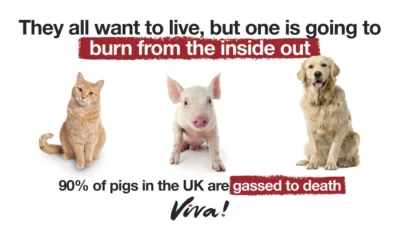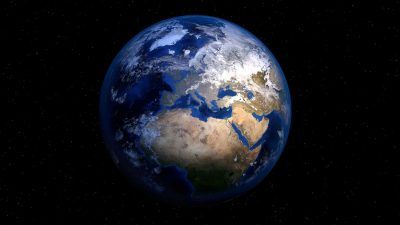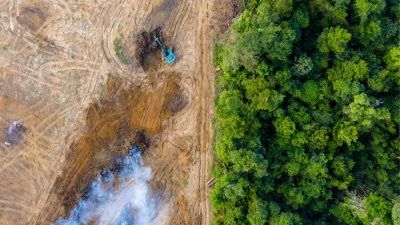Why dairy damages the environment

Plant-based milks have a much lower impact on the environment than cow’s milk but did you realise just how harmful dairy is? We reveal the huge difference between dairy and plant-based milks and show you how one simple swap can lower your carbon footprint substantially.
The dairy industry would have you believe that cow’s milk is natural and normal for us to drink. It’s neither, because we are not cows! This unnatural behaviour not only harms health, it also damages the environment and contributes to wildlife losses.
Why is cow’s milk so harmful for the environment?
Because of how their digestive systems work – fermenting their food – cows burp and fart out lots of methane. They produce surprisingly large amounts of this damaging greenhouse gas which is many times more potent than carbon dioxide (CO₂) in its climate change impacts. Add that to the cow’s urine and faeces stored in ‘slurry lagoons’, emitting even more greenhouse gases, and you may begin to understand why cow’s milk has such a large carbon footprint compared to plant milks.
Whether you look at the amount of land and water required, the amount of greenhouse gases produced or the amount of nutrient pollution (eutrophication) of our waterways, cow’s milk is the most damaging of all the milks.
A comparison of the environmental impacts of cow’s and plant-based milks. Impacts are measured per litre of milk.

Source: Poore and Nemecek, 2018.
The environmental impacts of cow’s milk
Greenhouse Gas Emissions
Cow’s milk produces around three times as much greenhouse gas emissions as plant milks (Ritchie, 2022). This is largely due to methane from the cows’ burps and farts plus the carbon footprint of growing farmed animal feed.
Land use
Cow’s milk uses around ten times as much land as plant milks (Ritchie, 2022). This is because dairy farming requires large amounts of land, both for grazing cows and growing feed crops. Although an increasing number of cows are zero-grazed and never see a blade of fresh grass, they all still need feeding. Growing farmed animal feed crops contributes to deforestation and habitat destruction.
Water use
Cow’s milk uses two to twenty times as much freshwater as plant milks (Ritchie, 2022). This is mainly because of the water required to grow feed crops for cows as well as to maintain the livestock. Globally, around three-quarters of all freshwater resources are now used for crop or livestock (grazing or animal feed) production (IPBES, 2019).
Eutrophication (nutrient pollution)
Cow’s milk creates much higher levels of water pollution (eutrophication) than plant milks (Ritchie, 2022). This is because chemicals running off farmland into estuaries and coastal waters are causing eutrophication, leading to aquatic dead zones.
Whichever way you look at it, cow’s milk has significantly higher environmental impacts than plant-based milks.
What’s the impact of your coffee?
In a typical EU diet, cow’s milk and dairy foods contribute a significant portion of your food-related emission accounting for over one-quarter of your carbon footprint, sometimes as much as one-third (Sandström et al., 2018).
Swapping to plant-based milks is one of the simplest dietary changes you can make towards a more sustainable way of living, with more and more people switching to soya, oat or almond milk in tea and coffee. It’s a small change, but one that can have far reaching effects. Swapping cow’s milk for soya or oat milk can cut your cup of coffee’s footprint by up to two-thirds.
A comparison of the carbon footprints of coffee made with cow’s milk and plant milks

Source: My Emissions
What is the impact of your cheese, yoghurt and cream?

Source: My Emissions
All plant milks require fewer resources than cow’s milk
Historically, people have used all sorts of plant milks because they are easy to make, use and digest. Coconut, soya and almond milks have been around for centuries if not millennia! They all have one thing in common – they’re made from plants and water, contain no animal hormones or cholesterol and require much fewer resources than cow’s milk.
Soya milk
Soya receives a lot of negative press due to deforestation in the Amazon. Swathes of the rainforest have been cleared for cattle grazing and soya cultivation. However, 95 per cent of Brazilian soya is used in animal feed (Poore and Nemecek, 2018). On the other hand, most soya milks available in Europe use Europe-grown soya – sustainable and good for the environment because soya plants bind nitrogen in the soil, enriching it, and require less fertiliser than many other crops.
Almond milk
Almond milk has also been subject to criticism in the media because almonds are said to be ‘thirsty’! However, while almond milk may be more water-intensive than other plant milks, cow’s milk requires still more water. The world’s largest almond producer is California, which has suffered severe droughts for several years but in California, the thirstiest crop is alfalfa – grown for livestock feed. The plant milk brand Alpro uses Spanish almonds for its almond milk. Also, don’t forget that almonds are trees and as such capture carbon dioxide from the atmosphere and release oxygen, and their roots help to prevent soil erosion.
Oat, hemp and pea milks
All these crops are or can be grown locally in the UK, don’t require extensive irrigation or fertilisers and are beneficial to our health. There is no downside but if you want the most sustainable option, choose organic versions of these because that means no pesticides were used.
Rice milk
Rice is grown in flooded rice paddies and because those produce methane, it has a higher greenhouse gas impact than other cereal crops. Yet, it’s still less than a half of what cow’s milk produces.
Coconut milk
Coconut plantations are scattered across subtropical coastal zones and while coconut growing is environmentally friendly, it’s the farmers that often struggle to make ends meet. Volatile market prices of coconuts mean they often don’t get paid as much as they should for their produce. From this point of view, the sustainable choice is the one that keeps coconut farmers out of poverty – Fair Trade products.
Bottom line
Animal agriculture is responsible for the majority of all food-related greenhouse gas emissions and for about 20 per cent of emissions overall. So why do we only see nutritional labels on products or calorie counts on menus?
Plant milks are better than dairy milk in every aspect – land use, water use, greenhouse gas emissions, sustainability and health. Whichever plant milk you choose, it will be a more sustainable option than cow’s milk.










